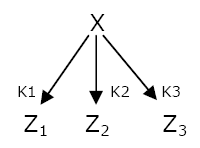Team:Paris/Analysis/Design1
From 2008.igem.org
(→The easiest way to control a sequential expression of gene) |
(→The easiest way to control a sequential expression of gene) |
||
| Line 5: | Line 5: | ||
==The easiest way to control a sequential expression of gene== | ==The easiest way to control a sequential expression of gene== | ||
[[Image:Vaiselle sale.jpg|thumb|left|The washing of dirty plates traditionally follows a LIFO order : the last plate on the stack is the first one to be washed]][[Image:SIM.png|thumb|right|Network 1 : The Single Input Module can generate a LIFO temporal order.]] | [[Image:Vaiselle sale.jpg|thumb|left|The washing of dirty plates traditionally follows a LIFO order : the last plate on the stack is the first one to be washed]][[Image:SIM.png|thumb|right|Network 1 : The Single Input Module can generate a LIFO temporal order.]] | ||
| - | The temporal order of expression that is the easiest to set up is the ''Last In First Out'' temporal order. The genetic network that generates this behavior is the ''Single Input Module (SIM)'' (''Network 1''). A transcription factor X activates the expression of different genes Z<sub>i</sub>. When X concentration increases, the threshold of activation of the different genes Z are reached in a precise order. The expression will stop in the opposite order when X is not expressed anymore. The first gene to be switched on will be the last one to be OFF. This order poses a real problem to us : several states of the system are redundant. We can not accept a clock that would display twice the same hour ! | + | The temporal order of expression that is the easiest to set up is the ''Last In First Out'' temporal order. The genetic network that generates this behavior is the ''Single Input Module (SIM)'' (''Network 1''). A transcription factor X activates the expression of different genes Z<sub>i</sub>. When X concentration increases, the threshold of activation K<sub>i</sub> of the different genes Z are reached in a precise order. The expression will stop in the opposite order when X is not expressed anymore. The first gene to be switched on will be the last one to be OFF. This order poses a real problem to us : several states of the system are redundant. We can not accept a clock that would display twice the same hour ! |
In the FIFO you could start by saying we were looking for a FIFO and rather than designing it from scratch we decided to look in nature where we found and adopted the flagella which then inspired us further | In the FIFO you could start by saying we were looking for a FIFO and rather than designing it from scratch we decided to look in nature where we found and adopted the flagella which then inspired us further | ||
Revision as of 18:54, 28 October 2008
|
Network Design - Part 1
Generating a FIFO sequential order of expressionA clock that would only indicate one hour, would not be very useful. The same goes for our BacteriO'clock. It is necessary that we add several distinct events in each cycle. We want to use three genes activated successively. The easiest way to control a sequential expression of geneThe temporal order of expression that is the easiest to set up is the Last In First Out temporal order. The genetic network that generates this behavior is the Single Input Module (SIM) (Network 1). A transcription factor X activates the expression of different genes Zi. When X concentration increases, the threshold of activation Ki of the different genes Z are reached in a precise order. The expression will stop in the opposite order when X is not expressed anymore. The first gene to be switched on will be the last one to be OFF. This order poses a real problem to us : several states of the system are redundant. We can not accept a clock that would display twice the same hour ! In the FIFO you could start by saying we were looking for a FIFO and rather than designing it from scratch we decided to look in nature where we found and adopted the flagella which then inspired us further |
 "
"


